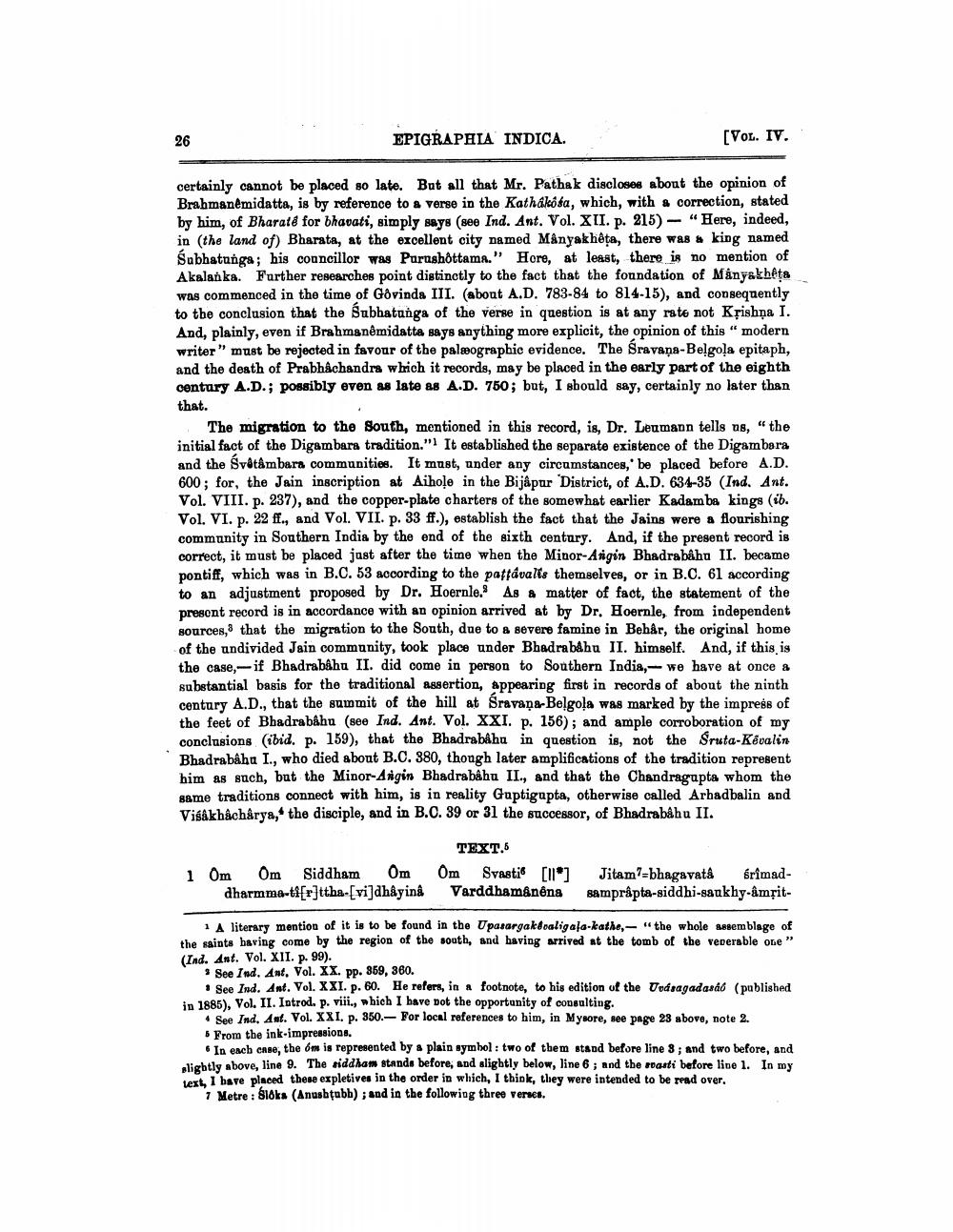________________
EPIGRAPHIA INDICA.
[VOL. IV.
certainly cannot be placed so late. But all that Mr. Pathak discloses about the opinion of Brahmanèmidatta, is by reference to a verse in the Kathakota, which, with a correction, stated by him, of Bharaté for bhavati, simply says (800 Ind. Ant. Vol. XII. p. 215) - “Here, indeed, in the land of) Bharata, at the excellent city named Månyakhêţa, there was a king named Sabhatunga; his councillor was Purushottama." Hore, at least, there is no mention of Akalanka. Further researches point distinctly to the fact that the foundation of Minyakbêts was commenced in the time of Govinda III. (about A.D. 783-84 to 814-15), and consequently to the conclusion that the Subhatanga of the verse in question is at any rate not Krishna I. And, plainly, even if Brahmanêmidatta says anything more explicit, the opinion of this " modern writer" must be rejected in favour of the palæographic evidence. The Sravana-Belgola epitaph, and the death of Prabhachandra which it records, may be placed in the early part of the eighth centary A.D.; Possibly even as late as A.D. 750; but, I should say, certainly no later than that.
The migration to the South, mentioned in this record, is, Dr. Leumann tells us, "the initial fact of the Digambara tradition." It established the separate existence of the Digambara and the Syötâmbara communities. It must, under any circumstances,' be placed before A.D. 600; for, the Jain inscription at Aihole in the Bijapur District, of A.D. 634-35 (Ind. Ant. Vol. VIII. p. 237), and the copper-plate charters of the somewhat earlier Kadamba kings (ib. Vol. VI. p. 22 ff., and Vol. VII. p. 33 ff.), establish the fact that the Jains were a flourishing community in Southern India by the end of the sixth century. And, if the present record is correct, it must be placed just after the time when the Minor-Argin Bhadrabahu II. became pontiff, which was in B.C. 53 according to the pattávalls themselves, or in B.C. 61 according to an adjustment proposed by Dr. Hoernle. As a matter of fact, the statement of the present record is in accordance with an opinion arrived at by Dr. Hoernle, from independent sources, that the migration to the South, due to a severe famine in Behår, the original home of the undivided Jain community, took place ander Bhadrabahu II. himself. And, if this is the case, if Bhadrabahu II. did come in person to Southern India, - we have at once & substantial basis for the traditional assertion, appearing first in records of about the ninth century A.D., that the summit of the hill at Sravana-Belgola was marked by the impress of the feet of Bhadrabahu (see Ind. Ant. Vol. XXI. p. 156); and ample corroboration of my conclusions (ibid. p. 159), that the Bhadrabiha in question is, not the Sruta-Kévalin Bhadrabaho I., who died about B.C. 380, though later amplifications of the tradition represent him as such, but the Minor-Angin Bhadrabahu II., and that the Chandragupta whom the game traditions connect with him, is in reality Guptigupta, otherwise called Arhadbalin and Visakhacharya, the disciple, and in B.C. 39 or 31 the successor, of Bhadrabåhu II.
1 Om Om Siddham Om
dharmma-ti[r]ttha-[vi]dhảyina
TEXT.5 Om Svasti [11]
Varddhamanens
Jitam?-bhagavatá srîmadsamprapta-siddhi-sankhy-âmţit
1 A literary mention of it is to be found in the Upasargaktoaligala-kathe, - "the whole assemblage of the saints having come by the region of the south, and having arrived at the tomb of the veperable one” (Ind. Ant. Vol. XII. p. 99).
. See Ind. Ant. Vol. XX. pp. 859, 360.
See Ind. Ant. Vol. XXI. p. 60. He refers, in a footnote, to his edition of the Uud sagadasco (published in 1885), Vol. II. Introd. p. viii., which I have not the opportunity of consulting.
4 See Ind. Ant. Vol. XXI. p. 850.- For local references to him, in Mysore, nee page 28 above, note 2. 6 From the ink-impressions.
In each case, the 6m is represented by a plain symbol : two of them stand before line 8; and two before, and alightly above, line 9. The siddham stands before, and slightly below, line 6; and the roasti before live 1. In my Text, 1 bave placed these expletives in the order in which, I think, they were intended to be read over.
7 Metre : S10ks (Anushtabb); and in the following three verses,




